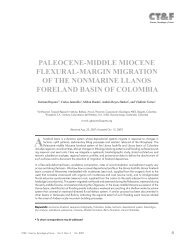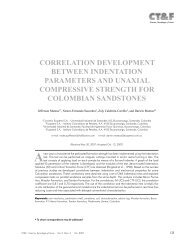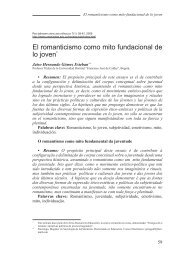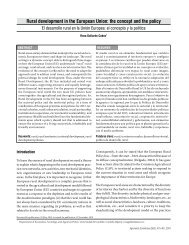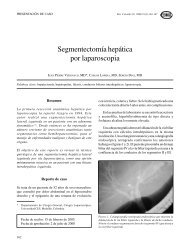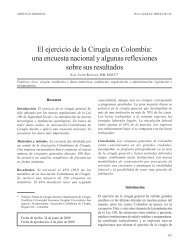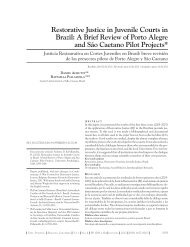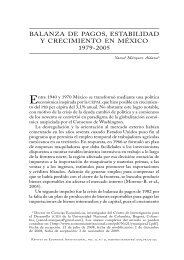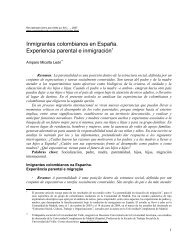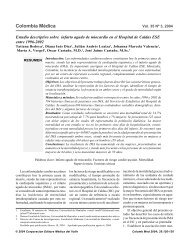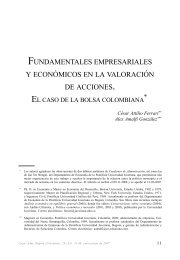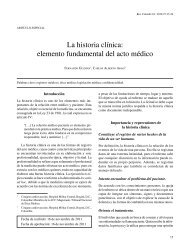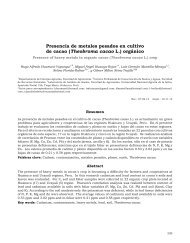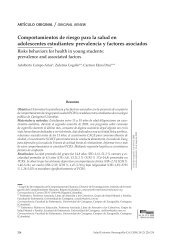aiphanes from colombia and venezuela
aiphanes from colombia and venezuela
aiphanes from colombia and venezuela
Create successful ePaper yourself
Turn your PDF publications into a flip-book with our unique Google optimized e-Paper software.
www.unal.edu.co/icn/publicaciones/caldasia.htm<br />
Caldasia Bernal 32(1):117-127. & Borchsenius 2010<br />
TAXONOMIC NOVELTIES IN AIPHANES (PALMAE)<br />
FROM COLOMBIA AND VENEZUELA<br />
Novedades taxonómicas en Aiphanes (Palmae) de Colombia y Venezuela<br />
RODRIGO BERNAL<br />
Instituto de Ciencias Naturales, Facultad de Ciencias, Universidad Nacional de Colombia,<br />
Apartado 7495, Bogotá D. C., Colombia. rgbernalg@unal.edu.co<br />
FINN BORCHSENIUS<br />
Department of Biological Sciences, Aarhus University, Ny Munkegade building 1540, 8000<br />
Aarhus C, Denmark.<br />
ABSTRACT<br />
Two new species of Aiphanes <strong>from</strong> Colombia, Aiphanes buenaventurae <strong>and</strong> Aiphanes<br />
multiplex, are described <strong>and</strong> illustrated. Two other species, Aiphanes killipii <strong>and</strong><br />
Aiphanes concinna, previously included in synonymy under Aiphanes horrida,<br />
<strong>and</strong> Aiphanes lindeniana, respectively, are restored. Aiphanes stergiosii described<br />
<strong>from</strong> Venezuela is included in synonymy under Aiphanes lindeniana. An epitype is<br />
designated for Aiphanes simplex.<br />
Key words. Arecaceae, Aiphanes, Colombia, Venezuela.<br />
RESUMEN<br />
Se describen e ilustran dos especies nuevas de Aiphanes de Colombia, Aiphanes<br />
buenaventurae y Aiphanes multiplex. Se restablecen además otras dos especies, Aiphanes<br />
killipii y Aiphanes concinna, previamente incluidas en sinonimia de Aiphanes<br />
horrida y Aiphanes lindeniana, respectivamente. Aiphanes stergiosii descrita de<br />
Venezuela, se incluye en la sinonimia de Aiphanes lindeniana. Se designa un epitipo<br />
para Aiphanes simplex.<br />
Palabras clave. Arecaceae, Aiphanes, Colombia, Venezuela.<br />
INTRODUCTION<br />
After the publication of our monograph of the<br />
palm genus Aiphanes (Borchsenius & Bernal<br />
1996), several changes in our underst<strong>and</strong>ing<br />
of the group have taken place, which make it<br />
necessary to re-evaluate the circumscription<br />
of some of the species recognized at that<br />
time. The discovery of several new species<br />
(Bernal 2001, Galeano & Bernal 2002, Cerón<br />
& Bernal 2004) has revealed that narrow<br />
endemism in the genus is more common than<br />
previously appreciated. On the other h<strong>and</strong>,<br />
new collections <strong>and</strong> the study of older ones not<br />
previously available to us have emphasized<br />
the need for a general update of the taxonomy<br />
of the genus. In the following we describe two<br />
new species <strong>and</strong> reassess the taxonomic status<br />
<strong>and</strong> delimitation of three others. Finally, an<br />
epitype is designated for Aiphanes simplex<br />
Burret.<br />
Aiphanes buenaventurae R. Bernal &<br />
Borchs. sp. nov. Fig. 1a-b<br />
Type. COLOMBIA. Valle del Cauca:<br />
Buenaventura, 6 May 1926 (fl ), O. F. Cook<br />
86<br />
(holotype, US).<br />
117
Taxonomic novelties in Aiphanes<br />
Aiphanes erinaceae foliis pinnis 13 in<br />
eodem plano fere regulariter dispositae,<br />
anguste cuneatis vel linearibus, medialis<br />
42-52 cm longis (vs. 14-32 cm), atque<br />
infl orescentia ramis paucis, fl oribus femineis<br />
crebre dispositis differt.<br />
Stem solitary or more often in clusters of 3-<br />
4, to 4 m tall, with adventitious roots up to 1<br />
m high on the stem. Leaves 5-8, spreading;<br />
sheath ca. 22 cm long, with a thin indumentum<br />
of brown scales <strong>and</strong> with brown <strong>and</strong> yellowish<br />
bicolor spines to 3 cm long; petiole ca. 25<br />
cm long, with scales like the sheath, with<br />
only a few scattered bicolor spines to 5.5<br />
cm; rachis 78 cm long, adaxially ridged,<br />
abaxially with a scaly indumentum like that<br />
of the sheath, covered on both sides with a<br />
dense indumentum of brown spinules ca. 0.5<br />
mm long, armed only toward the base with a<br />
few bicolor spines to 2 cm; pinnae 8-13 on<br />
each side, subregularly arranged in one plane,<br />
except for a basal group of fi ve rather closely<br />
118<br />
arranged pinnae, middle pinnae separated<br />
7-11 cm, plicate, narrowly cuneate to almost<br />
linear, 4-13 times as long as wide, oblique to<br />
incised-premorse at apex, often with a 1-3<br />
cm long fi nger-like projection on the distal<br />
margin, adaxially glabrous, abaxially sparsely<br />
<strong>and</strong> minutely pilose, <strong>and</strong> with a narrow<br />
marginal strip of brown scales, mostly along<br />
the distal margin, without spinules or spines;<br />
basal pinnae 12-18 x 0.5-4 cm; middle pinnae<br />
42-52 x 4 cm; apical pinnae 5-7 ribbed, 45-47<br />
cm long, 9-11 cm wide, occupying 15.4 cm<br />
along rachis. Infl orescences 90-123 cm long,<br />
interfoliar or infrafoliar when old; prophyll 35<br />
cm long, 1.5 cm wide; peduncular bract (only<br />
a fragment seen) apparently thin <strong>and</strong> fi brous;<br />
peduncle 68-90 cm long, 5-6 mm wide at<br />
apex, compressed, covered with brown<br />
scales <strong>and</strong> minute spinules, unarmed or with<br />
a few scattered, brown or yellow spines to 1<br />
cm long; rachis 21-24 cm long, with minute<br />
brown spinules; rachillae 8-12, evenly spaced<br />
3-4 cm apart along the rachis, covered with<br />
a b<br />
Figure 1. Aiphanes buenaventurae. a, detail of leaf: b, infl orescence (O.F. Cook 86, US).
minute brown spinules like those of the rachis,<br />
with brown scales mainly on the abaxial<br />
surface, only the pistillate portion seen; basal<br />
rachillae 25-32 cm long in the proximal, triadbearing<br />
portion, without fl owers for 1.5-2.5<br />
cm, triads loosely arranged toward base,<br />
progressively closer above, most densely<br />
arranged near the middle; apical rachillae with<br />
pistillate fl owers for ca. 6-7 cm; triads sunken<br />
into pits in the rachillae. Staminate fl owers<br />
not seen. Pistillate flowers 3.5 mm long;<br />
sepals broadly ovate, 1.8 mm long, glabrous;<br />
petals 3 mm long, connate for 1/2 their length,<br />
the lobes ovate, acute or rounded at apex,<br />
adaxially glabrous, abaxially with a few<br />
minute, scattered spinules; staminodial ring<br />
2.1 mm long, inconspicuously toothed, adnate<br />
to petals; pistil ca. 2 mm long, glabrous; fruits<br />
not seen.<br />
Distribution. Known <strong>from</strong> only two<br />
collections made at the bay of Buenaventura,<br />
on the Pacifi c coast of Colombia, near sea<br />
level.<br />
Conservation status.Aiphanes buenaventurae<br />
has been collected only twice in 84 years, in<br />
spite of the fact that extensive collections<br />
have been made in the Buenaventura area<br />
over this period. Since forest cover in the<br />
region has changed dramatically, this species<br />
must be considered as Critically Endangered,<br />
Endangered<br />
according to IUCN parameters (IUCN 2001),<br />
following criteria A2c -an estimated reduction<br />
of population size in more than 80% in the last<br />
three generations, due to causes that are still<br />
Table 1. Aiphanes buenaventurae <strong>and</strong> Aiphanes erinacea compared.<br />
Bernal & Borchsenius<br />
operating <strong>and</strong> have caused a reduction in its<br />
area of occupancy.<br />
Paratype. COLOMBIA. Valle del Cauca:<br />
Agua Dulce, an isl<strong>and</strong> in Buenaventura Bay,<br />
12 Feb 1967 (fl ), H. E. Moore et al. 9470<br />
(BH!).<br />
In our treatment of Aiphanes erinacea we<br />
discussed a geographically isolated specimen<br />
(Moore et al. 9470) resembling Aiphanes<br />
erinacea but with longer, more narrowly<br />
cuneate pinnae, inflorescences with few<br />
rachillae inserted at long intervals along a<br />
short rachis, <strong>and</strong> spiny pollen. We indicated<br />
that future studies would reveal whether it<br />
represented a different species or a wider<br />
circumscription of A. erinacea. The study of<br />
an old collection not available to us during<br />
our revision, as well as a better underst<strong>and</strong>ing<br />
of the morphological variation <strong>and</strong> narrow<br />
endemism in the genus, has led us to conclude<br />
that this entity represents a distinct species.<br />
Differences between Aiphanes erinacea <strong>and</strong><br />
Aiphanes buenaventurae are shown in table<br />
1.<br />
Aiphanes multiplex R. Bernal & Borchs.<br />
sp. nov. Fig. 2.<br />
Type. COLOMBIA. Valle del Cauca: Old rd.<br />
Cali-Buenaventura, 6-7 km below Queremal,<br />
1200-1300 m, 22 Mar 1988 (fl , fr), Bernal &<br />
Prado 1448 (holotype, COL; isotypes FTG,<br />
TULV).<br />
Character A. buenaventurae A. erinacea<br />
Middle pinnae length 50-69 cm 14-40 cm<br />
Middle pinnae shape Narrowly cuneate to almost linear Broadly cuneate<br />
Middle pinnae length/width ratio 4-13 1.5-4.5<br />
Number of rachillae 8-13 15-180<br />
Insertion of rachillae<br />
Evenly spaced 3-4 cm apart along<br />
the rachis<br />
Widely separated proximallly,<br />
densely crowded distally<br />
Pollen Spiny<br />
With densely positioned, sparsely<br />
fusing supratectal clavae<br />
119
Taxonomic novelties in Aiphanes<br />
Aiphanes gelatinosae habitu solitario, foliis<br />
majoribus pinnis anguste cuneatis atque<br />
fortiter plicatis, infl orescentiis 3-4 in quoque<br />
nodo, polline spinis carentibus, sepalis<br />
femineis minoribus, atque fructibus rubris<br />
apice bruneo differt.<br />
Stems solitary 3-9 m tall, 5.5-10 cm diam.,<br />
internodes armed with black, retrorse spines,<br />
to 23 cm long. Leaves 7-11, polistichous, erect<br />
<strong>and</strong> arching, lower ones borne horizontally;<br />
sheath 90-114 cm long, the distal part free<br />
<strong>and</strong> appearing like the petiole, armed with<br />
black spines to 12 cm long, these fewer<br />
distally <strong>and</strong> only to 2 cm long; petiole 5-17<br />
cm long; rachis 170-400 cm long, with a grey<br />
or brown, scaly, caducous indument, armed<br />
with numerous spinules <strong>and</strong> proximally<br />
with few to many black spines, to 2 cm<br />
long, distally without spines; pinnae 19-30<br />
per side, regularly inserted <strong>and</strong> held in one<br />
plane or in remote groups of 2-6 separated<br />
by up to 14 cm, in slightly divergent planes,<br />
always strongly plicate, often very rigid,<br />
narrowly cuneate, 5-8 times as long as wide,<br />
incised- praemorse <strong>and</strong> symmetrical around<br />
the midrib, with a fi nger-like projection up<br />
to 5 mm long on the distal margin, glabrous<br />
or with scattered scales <strong>and</strong> minute spinules<br />
abaxially; basal pinnae 20-26 x 3.9-5.1 cm;<br />
middle pinnae 30-67 x 6-14 cm; apical pinnae<br />
3-6 ribbed, 33-39 x 8-20 cm. Infl orescences<br />
interfoliar, 3-4 per node, sharing a common,<br />
3-4-chambered prophyll, curving, becoming<br />
pendulous, branched to one order with<br />
appressed rachillae; prophyll 34-72 x 7-<br />
8.5 cm; peduncular bract ca. 60 cm long<br />
or more, to 10 cm wide, thick, unarmed or<br />
spiny at apex, with a thick, brown, caducous<br />
indument; peduncle 151-240 cm long at<br />
anthesis, 5-10 mm in diam. at apex, densely<br />
armed (at least distally) with brownish<br />
black spines, to 3 cm long; rachis 23-29<br />
cm long, armed like peduncle, but spines<br />
shorter distally; rachillae 22-24, white at<br />
anthesis, appressed to rachis, the distal ones<br />
somewhat spreading; basal rachillae to 20<br />
120<br />
cm long, armed with black, crimped spines<br />
to 1 cm long, the proximal half thickened,<br />
to 1.5 cm wide, with densely packed triads,<br />
basally only with fl owers abaxially, distal<br />
half slender, 2-3 mm diam., with densely<br />
packed staminate dyads; apical rachillae<br />
8-11 cm long, slender, staminate; triads<br />
sunken into deep pits, staminate flowers<br />
borne marginally on 2-3 mm long pedicels;<br />
dyads borne in shallow cavities, surrounded<br />
by fused, ca. 1 mm tall bracts, the proximal<br />
fl ower of each dyad sessile, the distal with<br />
a ca. 1 mm long pedicel. Staminate fl owers<br />
greenish, the petals with purple margins, 1.5-<br />
2.5 mm long; sepals narrowly triangular, not<br />
overlapping, 1-2 x 0.5-1 mm; petals basally<br />
connate, valvate, strongly striate when dry,<br />
2-2.5 x 1.5-2 mm; fi laments ca. 0.5 mm long,<br />
anthers slightly longer than wide, 0.4-0.7 x<br />
0.5-0.7 mm; pistillode minute, sunken into<br />
the swollen, 0.7-0.8 mm thick receptacle.<br />
Pistillate fl owers purple or the petals green<br />
with purple margins, with green ovary <strong>and</strong><br />
pale pink stigmas, ca. 7 mm long; sepals<br />
broadly ovate, imbricate, 2 mm long, much<br />
shorter than petals <strong>and</strong> then enclosed in<br />
the fl ower pit; petals very thick, connate<br />
for /3 of their length, valvate distally, ca.<br />
6-7 x 5 mm; staminodial cup 3-4 mm tall,<br />
nearly truncate; pistil glabrous. Fruits red<br />
with black apex at fi rst, fi nally bright red,<br />
subglobose, somewhat acute at base, 15 x 17<br />
mm, green on basal unexposed part, rostrate<br />
1-2 mm; endocarp 1 1-14 x 13-16 mm, more<br />
or less acute at base, prominently pitted <strong>and</strong><br />
irregularly grooved.<br />
Paratypes. COLOMBIA. Valle del Cauca:<br />
Old rd. Cali-Buenaventura, km 50, 1 km W of<br />
Queremal, 12 Mar 1975 (fem fl , fr), Anderson<br />
31 (BH); Cauca: El Tambo, Munchique<br />
National Park, vereda El Condor, upper Santa<br />
Lucía creek, 2º44’02’’N, 76º56’57’’, 1600-<br />
1800 m,19 Jun 2001, Bernal & Lopera 2837<br />
(COL); Reserva Natural Tambito, 2° 30’ 17”<br />
N, 77° 59’ 37.9” W, 1600 m, 25 May 2000,<br />
Casañas 242 (CAUP, COL); 2° 30’ 57.3” N,
77° 59’ 54” W, 1597 m, 11 Jan 2001, Casañas<br />
770 (CAUP, COL). ECUADOR. Carchi:<br />
Environs of Maldonado, 1450-1650 m, 30 May<br />
1978 (fr), Madison et al. 4804 (SEL); El Pailon,<br />
ca. 45 km below Maldonado along foot path<br />
to Tobar Donoso, 800 m, 30 Nov 1979 (fl , fr),<br />
Madison & Besse 7187 (BH, K, QCA, SEL);<br />
trail Gualpi Alto-La Guana, km 3, on highest<br />
point, 1000 m, 15 May 1985 (fem fl , fr), Barfod<br />
& Skov 60003 (AAU, COL, MO, NY).<br />
Distribution. Western slopes of the Andes<br />
in southern Colombia (Valle <strong>and</strong> Cauca) <strong>and</strong><br />
northern Ecuador (Carchi). There is an area<br />
in between, in the department of Nariño,<br />
Colombia, where the species has not been<br />
found. It may have been overlooked or<br />
mistaken for A. gelatinosa, but its occurrence<br />
in this area is likely.<br />
Conservation status. At present Aiphanes<br />
multiplex is not threatened, due to the extense<br />
forest cover of the areas where it grows. It<br />
is furthermore protected in the Muchique<br />
National Park, in Colombia.<br />
Figure 2. Infl orescences of Aiphanes multiplex<br />
(Bernal 1448, COL, FTG, TULV).<br />
Bernal & Borchsenius<br />
In our treatment of Aiphanes gelatinosa<br />
(Borchsenius & Bernal 1996), we recognized<br />
two morphological forms, which we thought<br />
might represent different taxa. Plants <strong>from</strong> the<br />
type locality have caespitose stems, linear,<br />
weakly plicate pinnae, single infl orescences,<br />
<strong>and</strong> spiny pollen, whereas plants <strong>from</strong> two<br />
different localities north <strong>and</strong> south of the<br />
type locality have solitary stems, narrowly<br />
cuneate, strongly plicate pinnae, multiple<br />
infl orescences <strong>and</strong> pollen without spines.<br />
The latter form was informally called by<br />
us ‘triplex.’ The lack of further evidence,<br />
however, made us refrain <strong>from</strong> giving this<br />
form any taxonomic status. Given our current<br />
undert<strong>and</strong>ing of intra- <strong>and</strong> interspecific<br />
variation in the genus, however, we recognize<br />
that this was clearly a mistake. Preliminary<br />
molecular evidence (Borchsenius et al.<br />
unpublished data) also indicate that typical<br />
A. gelatinosa <strong>and</strong> the form called ‘triplex’<br />
by us belong to different clades. As a new<br />
collection <strong>from</strong> Munchique National Park<br />
has four infl orescences per node, we have<br />
preferred the name multiplex instead of the<br />
misleading triplex. Differences between the<br />
two species are shown in table 2.<br />
Aiphanes killipii (Burret) Burret vs.<br />
Aiphanes horrida (Jacq.) Burret<br />
Burret (1932a) described Martinezia killipii<br />
based on a collection made by E. P. Killip<br />
in the department of Sant<strong>and</strong>er, Colombia,<br />
in 1927. A few months later, in his synopsis<br />
of Aiphanes (Burret 1932b), he transferred<br />
the species to this genus. Burret considered<br />
Aiphanes killipii to be closely related to A.<br />
horrida (as A. caryotifolia), <strong>from</strong> which<br />
he separated it on account of the spinulose<br />
fruits, the abundant yellowish spinules on<br />
the infructescence, the rachillae not curved<br />
at the insertion of each staminate fl ower,<br />
the larger fruits <strong>and</strong> fruiting perianth, <strong>and</strong><br />
the pinnae more abruptly <strong>and</strong> strongly<br />
broadened.<br />
121
Taxonomic novelties in Aiphanes<br />
Table 2. Aiphanes multiplex <strong>and</strong> Aiphanes gelatinosa compared (modifi ed <strong>from</strong> Borchsenius<br />
& Bernal 1996).<br />
Character A. multiplex A. gelatinosa<br />
Habit Solitary Cespitose<br />
Number of leaves 7-11 4-6<br />
Leaf rachis length 170-400 cm 110-150 cm<br />
Middle pinnae shape Narrowly cuneate Linear<br />
Middle pinnae length/width ratio 5-8 10-12<br />
Middle pinnae apex shape Incised praemorse Obliquely praemorse<br />
Pinna structure Strongly plicate Weakly plicate<br />
Infl orescences Three-four per node One per node<br />
Pollen Without spines With long spines<br />
Pistillate sepals length 2 mm 6 mm<br />
Fruit size ca. 15 x 17 mm 12-13 x 13-14 mm<br />
Fruit color<br />
Red with black apex at fi rst, fi nally<br />
bright red<br />
Red with black apex<br />
Infructescences Not encased in jelly Encased in jelly<br />
Based on the only collection available at the<br />
time of our study, the type specimen without<br />
a fi eld description, we included A. killipii in<br />
synonymy under A. horrida (as A. aculeata).<br />
However, a recent re-collection of Aiphanes<br />
killipii <strong>from</strong> Sant<strong>and</strong>er, ca. 116 km S of the<br />
type locality, shows that the type was not<br />
just a deviating individual of A. horrida,<br />
but represents a population with constant<br />
morphological characteristics <strong>and</strong> spanning a<br />
substantial geographic area. The conclusion<br />
is that Burret’s taxon should be treated as a<br />
separate species, differing <strong>from</strong> A. horrida<br />
in a number of morphological characters<br />
(Table 3).<br />
Aiphanes killipii (Burret ) Burret,<br />
Notizbl.<br />
Bot. Gart. Berlin-Dahlem 11: 561. 1932. Fig.<br />
3-4.<br />
Martinezia killipii Burret, Notizbl. Bot.<br />
Gart. Berlin-Dahlem 11: 326. 1932. Type.<br />
COLOMBIA, Sant<strong>and</strong>er, Río Suratá valley,<br />
between Bucaramanga <strong>and</strong> El Jaboncillo,<br />
800-1500 m, 2 Jan 1927, Killip & Smith<br />
16362 (holotype, B, destroyed; isotypes, A,<br />
BH, GH, US).<br />
Stem solitary, 2.5-4 m tall, 4.5-5 cm<br />
diameter, with black spines to 10 cm long.<br />
122<br />
Leaves 12; sheath 30 cm long, with black<br />
spines to 3.5 cm; petiole 44 cm long, with<br />
black spines; rachis 163 cm, glabrous,<br />
armed above <strong>and</strong> below with black spines<br />
to 5.5 cm long; pinnae 33 on each side,<br />
in groups of 3-4, inserted at different<br />
angles, groups occupying 2-4.5 cm along<br />
the rachis, separated by gaps 17-20 cm<br />
long, pinnae very narrow for most of their<br />
length, <strong>and</strong> abruptly widening near apex,<br />
2.2-3.7 times as long as wide, incised to<br />
truncate or bicuspidate at apex, glabrous on<br />
both sides, sometimes with a black spine<br />
to 3 cm long on the midvein below; basal<br />
pinnae 25-42 x 4.5-12.5 cm; middle pinnae<br />
31-42 x 13-17 cm; apical pinnae 27.5-30 x<br />
7.5-14.5 cm. Infl orescence erect or curved,<br />
pendulous in fruit, once branched; peduncle<br />
80 cm long, with brownish indumentum,<br />
densely armed with black (yellowish in<br />
bud) spines to 4 cm long; peduncular bract<br />
>52 cm long, 2.4 cm wide, coriaceous, with<br />
brown indumentum, unarmed; rachis 28-<br />
38 cm long, with indumentum like that of<br />
the peduncle, with abundant short spinules<br />
up to 0.1 mm long, <strong>and</strong> scattered spines<br />
up to 1 cm, mostly near base; rachillae<br />
54-62, densely spinulose; basal rachillae<br />
17-20 cm long, with a basal sterile portion<br />
up to 12 mm, with triads in the basal 1/3-
1/4 their length; apical rachillae ca. 10 cm<br />
long, mostly staminate. Flowers yellowish;<br />
staminate fl owers 4-7 mm long; sepals<br />
ovate-acuminate, carinate toward the apex,<br />
1.8-3 mm long, with a short, rounded spur at<br />
base; petals shortly connate at base, ovate,<br />
acute, 4-7 mm long; anthers linear, dorsifi x,<br />
2.2-3 mm long; connective dark; pitillode<br />
minute, trifi d. Pistillate fl owers (immature)<br />
4.3 mm long; sepals broadly ovate, 2.5 mm<br />
long; petals ovate, 5 mm long; staminodial<br />
cup 4 mm long, with triangular teeth 1 mm<br />
long; pistil 3.3 mm long, the ovary densely<br />
covered with whitish trichomes to 1 mm<br />
long. Fruit subglobose, brownish, 1.5-1.6<br />
cm long, 1.7-1.8 cm diam., with an abrupt<br />
rostrum to 2 mm long, the epicarp with<br />
dense brown tomentum <strong>and</strong> scattered, dark<br />
spinules to 1 mm long; endocarp globose,<br />
11-13 mm diam., shallowly pitted, with<br />
three equatorial pores.<br />
Table 3. Aiphanes killipii <strong>and</strong> Aiphanes horrida compared.<br />
Bernal & Borchsenius<br />
Distribution. Currently known <strong>from</strong> only<br />
one locality on the Eastern Cordillera in<br />
Colombia, ca. 116 km S of the type locality.<br />
At this area, A. killipii grows in very narrow<br />
forest remnants along a creek, surrounded by<br />
pastures. The species was not found at its type<br />
locality during a search for it in 1987.<br />
Specimen examined. COLOMBIA:<br />
Sant<strong>and</strong>er, Mun. Suaita, corregimiento de<br />
San José de Suaita, carretera a Guadalupe,<br />
500 m de San José, 6º 9´ N, 73º 21´ W, 1400<br />
m, 29 Sep 2003, Bernal 3433 (COL).<br />
Conservation status. Aiphanes killipii must<br />
be considered as Critically Endangered,<br />
according with the parameters of IUCN<br />
(IUCN 2001), following criteria A2c --an<br />
estimated reduction of population size in more<br />
than 80% in the last three generations, due to<br />
causes that are still operating <strong>and</strong> have caused<br />
a reduction in its area of occupancy.<br />
Character Aiphanes killipii Aiphanes horrida<br />
Stem diameter 4.5-5 cm 10-15 cm<br />
Sheath spines to 3.5 cm to 13.5 cm<br />
Petiole length 44 cm 0-1 cm<br />
Apex of pinnae Incised to truncate or bicuspidate Tricuspidate<br />
Apical pinnae connate for 2 cm 5-7.5 cm<br />
Number of veins in apical pinnae 2 4-7<br />
Peduncle length 80 cm 45-50 cm<br />
Peduncle diameter 5 mm 8-15 mm<br />
Rachis length 28-38 cm 44-50<br />
Indument of rachillae Densely spinulose With white scales, without spinules<br />
Insertion of staminate fl owers<br />
Shallow depressions on the rachilla,<br />
rachillae slightly arched at each<br />
fl ower, 2 small bracteoles<br />
Staminate fl owers length 4-7 mm 4-5.5 mm<br />
Rachillae projected into a hookshaped<br />
structure to 1 mm, where<br />
the staminate fl owers are inserted<br />
Shape of staminate sepals Ovate-acuminate Narrowly triangular, carinate<br />
Length of staminate sepals 2-3 mm 1-2 mm<br />
Length of staminate petals 4-7 mm 2.5-5.5 mm<br />
Indument of Pistil<br />
Densely covered with whitish<br />
trichomes to 1 mm long<br />
Glabrous<br />
Epicarp Brown, spinulose Mostly red, smooth<br />
123
Taxonomic novelties in Aiphanes<br />
Figure 3. Aiphanes killipii. a, habit; b, detail of leaves. Colombia, Sant<strong>and</strong>er. Photos by R.<br />
Bernal.<br />
Figure 4. Fruits of Aiphanes killipii (R. ( Bernal 3433 3433,<br />
COL).<br />
124<br />
a b
Aiphanes lindeniana (H. Wendl.) H. Wendl.,<br />
Aiphanes concinna H.E. Moore, <strong>and</strong><br />
Aiphanes stergiosii M. Niño, Dorr & F.W.<br />
Stauffer<br />
Aiphanes lindeniana was described by<br />
Wendl<strong>and</strong> (1857) as Martinezia lindeniana,<br />
based on a specimen collected by Funk &<br />
Schlim in Florida, S<strong>and</strong><strong>and</strong>er, in northeastern<br />
Colombia, at 1800 m of elevation. Our<br />
interpretation of this name (Borchsenius<br />
& Bernal 1996) was based on the rather<br />
incomplete lectotype at LE, <strong>and</strong> on an<br />
incomplete topotypic collection made in<br />
1987, <strong>and</strong> we concluded that it was the<br />
same entity as the one described <strong>from</strong> the<br />
mountains of Cundinamarca as Aiphanes<br />
concinna H.E. Moore. We, therefore, placed<br />
the latter in synonymy of A. lindeniana.<br />
In 2004, one of us (RB) made new <strong>and</strong><br />
complete collections of Aiphanes lindeniana<br />
at the original locality. About the same time,<br />
a new species, Aiphanes stergiosii, based on<br />
plants similar to these, was proposed by Niño<br />
et al. (2005) <strong>from</strong> the Andes of Venezuela.<br />
Comparison of an isotype collection of A.<br />
stergiosii in US <strong>and</strong> the recent topotypic<br />
collections of A. lindeniana, lead to the<br />
unambiguous conclusion that these represent<br />
a single species, the one described by<br />
Wendl<strong>and</strong> as A. lindeniana, <strong>and</strong> that this<br />
species differs <strong>from</strong> A. concinna in a number<br />
of characters. Aiphanes lindeniana is a<br />
solitary palm with polystichous leaves that<br />
have 18-31 narrowly cuneate pinnae per side,<br />
these with the margins usually spineless; A.<br />
concinna is cespitose, with distichous leaves<br />
that have 32-45 linear to lanceolate pinnae<br />
per side, the pinna margins densely spiny. We<br />
therefore, reinstate A. concinna as a distinct<br />
taxon, <strong>and</strong> place A. stergiosii in synonymy<br />
of A. lindeniana.<br />
Aiphanes lindeniana (H. Wendl.) H. Wendl.<br />
in Kerch., Les Palmiers 230. 1878.<br />
Bernal & Borchsenius<br />
Martinezia lindeniana H. Wendl., Linnaea 28:<br />
349. 1857. Type. COLOMBIA, Sant<strong>and</strong>er<br />
[“Pamplona”], Florida, 2000 m, Funck &<br />
Schlim 1655 (lectotype, annotated by N.<br />
Imschanitzkaja, LE).<br />
Aiphanes stergiosii M. Niño, Dorr & F.W.<br />
Stauffer, Sida 21(3): 1600. 2005. Syn. Nov.<br />
Type. VENEZUELA, Portuguesa, Mun.<br />
Sucre: Parque Nacional Guaramacal, “La<br />
Concepción” (Coord UTM 19-382173<br />
E, 1.033.526 N), 1700 m, Dec 2000, M.<br />
Niño & B. Stergios 1431 (holotype, PORT;<br />
isotypes K, US!, VEN, Z-ZT)<br />
Distribution. Southern slopes of the Andes<br />
in western Venezuela (Portuguesa), Eastern<br />
Cordillera of Colombia in Sant<strong>and</strong>er, <strong>and</strong><br />
Central Cordillera of Colombia in Antioquia,<br />
just across the Magdalena valley <strong>from</strong><br />
Sant<strong>and</strong>er. Grows in cloud forest at 1600-2000<br />
m. Probably grows also in the intervening<br />
areas of Norte de Sant<strong>and</strong>er (Colombia) <strong>and</strong><br />
Mérida (Venezuela).<br />
Conservation status. Aiphanes lindeniana<br />
must be considered as Endangered, Endangered according<br />
to IUCN parameters (IUCN 2001), following<br />
criteria B1abiii (restricted distribution<br />
represented by very few localities <strong>and</strong> habitat<br />
in continued deforestation).<br />
Specimens examined. COLOMBIA.<br />
Antioquia: Santa Rita, 5 km E of Guatape,<br />
2000 m, 17 Sep 1987 (fl ), Bernal & Tobón 1375<br />
(AAU, COL); Sant<strong>and</strong>er: Mun. Floridablanca,<br />
trail between hill La Judía <strong>and</strong> San Ignacio. 7°<br />
6’ N, 72° 56’ W, 1900 m, 24 Jun 2004, Bernal &<br />
Acosta 3574 (COL); Mun. Tona, 2-4 km on rd.<br />
<strong>from</strong> El 18 (km 16 on Bucaramanga-Pamplona<br />
rd.) to Tona, 1800 m, 7° 8’N, 72° 59’W, 20<br />
Jun 2004, Bernal & Acosta 3484 (COL); 7<br />
km S of the road Bucaramanga-Pamplona,<br />
on the road to Piedecuesta, 2200 m, Bernal &<br />
Galeano 1352 (AAU, COL). VENEZUELA.<br />
Portuguesa: Mun. Sucre, Alto de la Divisoria<br />
de La Concepción, southern slope of Parque<br />
Nacional Guaramacal, Coord. UTM 19-367038<br />
125
Taxonomic novelties in Aiphanes<br />
E, 1022723 N, 1880 m, 21 Jan 2000, Cuello et<br />
al. 1868 (US).<br />
The type locality of Aiphanes lindeniana has<br />
been cited (Borchsenius & Bernal 1996) as<br />
Pamplona, in Norte de Sant<strong>and</strong>er. However,<br />
this is a mistake, as Wendl<strong>and</strong> states in the<br />
protologue that the plant was collected<br />
“in the forests at Florida”, which is on the<br />
western slopes of the Cordillera Oriental<br />
in Sant<strong>and</strong>er. The present departments of<br />
Sant<strong>and</strong>er <strong>and</strong> Norte de Sant<strong>and</strong>er were<br />
referred to in the 19 th century as Provincia<br />
de Pamplona.<br />
Niño et al. (2005) distinguished A. stergiosii<br />
<strong>from</strong> A. lindeniana by a less robust habit,<br />
<strong>and</strong> the presence of fewer <strong>and</strong> shorter spines.<br />
They also noted that A. lindeniana tends to<br />
be a clustered palm whereas A. stergiosii was<br />
solitary. As key characters they mentioned<br />
differences in the indument of the leaf axis <strong>and</strong><br />
pinnae, as well as the presence in A lindeniana<br />
of small spines lining the pinna margins<br />
<strong>and</strong> major veins. The differences were,<br />
however, established through comparison<br />
with specimens of A. concinna <strong>from</strong> the<br />
central part of the Cordillera Oriental in<br />
Colombia (Cundinamarca, Huila) <strong>and</strong> not with<br />
specimens of the true A. lindeniana described<br />
by Wendl<strong>and</strong> <strong>from</strong> Northern Colombia. The<br />
latter populations correspond in all aspects<br />
to A. stergiosii. It may also be added that<br />
indument <strong>and</strong> spine characters are notoriously<br />
labile in species of Aiphanes (Borchsenius<br />
& Bernal 1996), so minor differences in<br />
these characters observed in a small number<br />
of specimens should be interpreted with<br />
caution.<br />
The specimens cited above include all<br />
collections of A. lindeniana that we have seen.<br />
Two were cited by Borchsenius <strong>and</strong> Bernal<br />
(1996): Bernal & Tobón 1375 <strong>and</strong> Bernal<br />
& Galeano 1352. All other specimens cited<br />
under A. lindeniana in the monograph are A.<br />
concinna.<br />
126<br />
Aiphanes concinna H.E. Moore, Gentes<br />
Herb. 8: 223, fi g. 91. 1951. Type. COLOMBIA.<br />
Cundinamarca: near Fusagasugá, 3000 m, 12<br />
Oct 1946, Foster & Foster 1870 (holotype,<br />
BH; isotype A).<br />
Distribution. Eastern Cordillera of Colombia<br />
<strong>from</strong> S Sant<strong>and</strong>er south to Putumayo, <strong>and</strong><br />
Central Cordillera of Colombia <strong>from</strong> Huila<br />
to Antioquia. Grows in cloud forest at 1700-<br />
3000 m.<br />
Conservation status. Aiphanes concinna<br />
has been considered as Not threatened by<br />
Galeano & Bernal (2005).<br />
New specimens not cited by Borchsenius<br />
<strong>and</strong> Bernal (1996). COLOMBIA.<br />
Cundinamarca: Mun. San Francisco,<br />
vereda El Peñón, Finca La Cumbre, 2000<br />
m, 7 Nov 1997, Albesiano et al. 596 (COL).<br />
Putumayo: Rd. <strong>from</strong> Sibundoy to Mocoa,<br />
beyond milestone of km 109, 2200 m,16 Jun<br />
2000, Bernal et al. 2485 (COL). Sant<strong>and</strong>er:<br />
Charalá, El Bogotacito, El Carmen-Virolín<br />
rd., 2300 m, 23 Nov 1994, Betancur et al.<br />
5829 (COL).<br />
An epitype for Aiphanes simplex Burret<br />
Aiphanes simplex was described by Burret<br />
(1932) based on a specimen collected by W.<br />
Kalbreyer in Antioquia, Colombia. There<br />
are many collections of this species, <strong>and</strong> it<br />
is well defi ned <strong>and</strong> clearly understood. The<br />
type specimen was kept at B, where it was<br />
destroyed in World War II, except for a single<br />
staminate flower (Borchsenius & Bernal<br />
1996), which scarcely serves any taxonomic<br />
purpose. After our monograph was submitted,<br />
the concept of epitype was introduced at<br />
the Tokyo Code (Greuter et al. 1994), <strong>and</strong><br />
therefore we here designate an epitype for<br />
this species.<br />
Aiphanes simplex Burret, Notizbl. Bot.<br />
Gart. Berlin-Dahlem 11: 567. 1932. Type.
COLOMBIA, Antioquia: Río Verde, 1500-<br />
1700 m, 28 Jul 1880, Kalbreyer 1864<br />
(holotype, B, a single staminate flower).<br />
Epitype. COLOMBIA, Mun. Medellín,<br />
Palmitas, quebrada Miserengo, 1900-2000<br />
m, 18 Mar 1979 (fl , imm fr), Galeano et al.<br />
14 (COL, HUA).<br />
LITERATURE CITED<br />
BERNAL, R. 2001. Una nueva especie de<br />
Aiphanes (Palmae) de los Andes de<br />
Colombia. Caldasia 23(1): 163-167.<br />
BORCHSENIUS, F. & R. BERNAL. 1996. Aiphanes<br />
(Palmae). Flora Neotropica 70: 1-95.<br />
BURRET, M. 1932a. Palmae neogeae. Notizbl.<br />
Bot. Gart. Berlin-Dahlem 11: 313-327.<br />
BURRET, M. 1932b. Die Palmengattungen<br />
Martinezia und Aiphanes. Notizbl. Bot.<br />
Gart. Berlin-Dahlem 11: 557-577.<br />
CERÓN, C. E. & R. BERNAL. 2004. Una nueva<br />
especie de Aiphanes (Palmae) del occidente<br />
de Ecuador. Caldasia 26 (2): 433-438.<br />
GALEANO, G. & R. BERNAL. 2002. New species<br />
<strong>and</strong> new records of Colombian palms.<br />
Caldasia 24: 277-292.<br />
GALEANO, G. & R. BERNAL. 2005. Palmas<br />
(familia Arecaceae o Palmae). Pp. 59-223<br />
in: E. Calderón, G. Galeano & N. García<br />
Bernal & Borchsenius<br />
(eds.). Libro Rojo de Plantas de Colombia,<br />
Volumen 2. Ministerio de Ambiente,<br />
Vivienda y Desarrollo Territorial/ Instituto<br />
Alex<strong>and</strong>er von Humboldt/Instituto de<br />
Ciencias Naturales, Bogotá.<br />
GREUTER, W., F. R. BARRIE, H. M. BURDET,<br />
W. G. CHALONER, V. DEMOULIN, D. L.<br />
HAWKSWORTH, P. M. JØRGENSEN, D. H.<br />
NICOLSON, P. C. SILVA, P. TREHANE, J. &<br />
MCNEILl. 1994. International Code of<br />
Botanical Nomenclature (Tokyo Code).<br />
Regnum Vegetabile 131. Koeltz Scientifi c<br />
Books, Königstein.<br />
IUCN. 2001. IUCN red list categories: Version<br />
3.1. Prepared by the IUCN Species Survival<br />
Commission. IUCN, Gl<strong>and</strong>, Switzerl<strong>and</strong>,<br />
<strong>and</strong> Cambridge.<br />
NIÑO, S.M., L.J. DORR & F.W. STAUFFER. 2005.<br />
Una nueva especie de Aiphanes (Arecaceae)<br />
de la Cordillera de Mérida, Venezuela. Sida<br />
21(3): 1599-1606.<br />
WENDLAND, H. 1857. Einige neue Palmen<br />
Amerika’s. Linnaea 28: 333-352.<br />
Recibido: 01/09/2009<br />
Aceptado: 21/04/2010<br />
127
Taxonomic novelties in Aiphanes<br />
128



